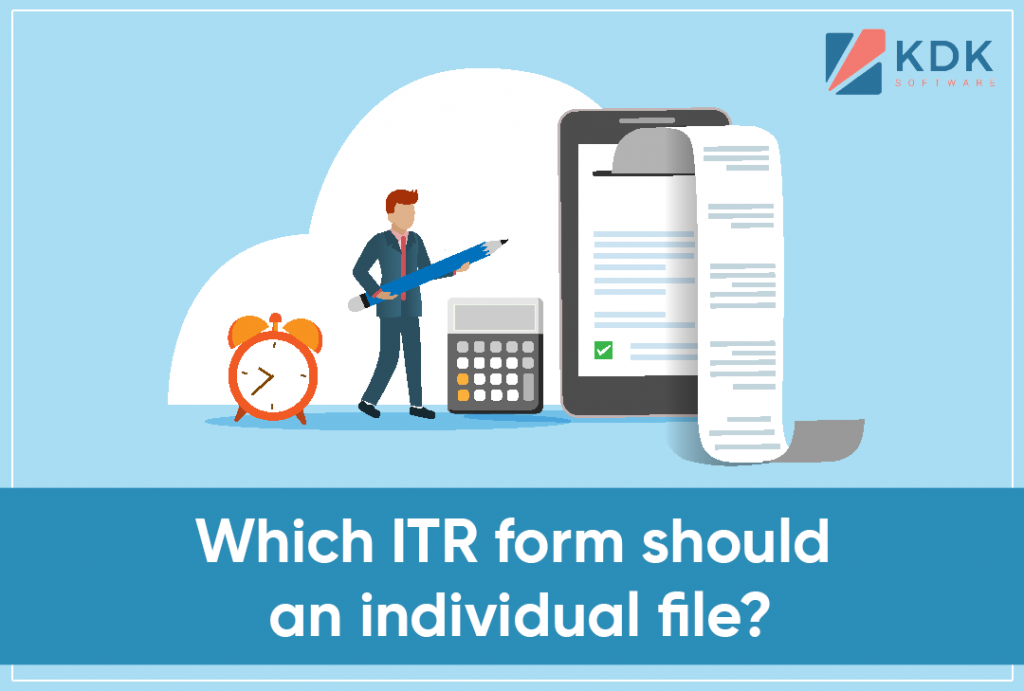Which ITR form should an individual file?

Income Tax Returns, or ITR, is a type of form where taxpayers disclose and file their incomes earned in the concerned financial year to the Income Tax Department. All citizens, living in or outside the country, having an income that is taxable or those who meet with the conditions specified by the Income Tax Department are required to file their ITR before the specified due date.
It is compulsory to file for tax returns in India if the person, with a taxable income, is within the following conditions.
- If the gross earnings exceed the limit of the exception set by the IT Department, the person is liable to disclose and file their income.
| Particulars | Amount |
| For individuals below 60 years | Rs 2.5 Lakh |
| For individuals above 60 years but below 80 years | Rs 3.0 Lakh |
| For individuals above 80 years | Rs 5.0 Lakh |
- If the person has more than one source of income.
- If the person wants to claim an income tax refund from the authorities.
- If the person has earned from, or invested in, a foreign firm/assets during the concerned financial year.
- If the person wishes to apply for a visa or a loan
- If the taxpayer is not an individual, but a company, firm or an organisation.
Now, the challenge is to figure out which ITR form one actually has to fill. The authorities have specified 7 different forms – namely ITR-1, ITR-2, ITR-3 , ITR-4, ITR-5, ITR-6 and ITR-7. Let’s take a look at each one.
ITR-1 or SAHAJ
This return form is supposed to be filed by an individual whose gross income for the financial year consists of either:
- Income derived from a salary or a pension. (income not exceeding ₹50,00,000)
- Income derived from One House Property (excluding cases where the losses from the previous year is brought on).
- Income derived from other miscellaneous (except sources like permitted legal gambling and lotteries). (income not exceeding ₹50,00,000)
- Income upto ₹5000, which is derived from agriculture.
ITR-2
This return form is supposed to be filled by an individual or a Hindu Undivided Family (HUF) whose gross income for the financial year consists of either:
- Income derived from a salary or a pension. (income not exceeding ₹50,00,000)
- Income derived from more than one House Properties. (income not exceeding ₹50,00,000)
- Income derived from miscellaneous sources. (income exceeding ₹50,00,000)
- If the person is an Individual Director of the company.
- If the person has unlisted equity shares during the concerned financial year.
- If the person is a Resident Not Ordinarily Resident (RNOR) or a Non-Resident.
- If the person has derived their income from a foreign asset.
- Income of ₹5000 and above, which is derived from agriculture.
ITR-3
This return form is supposed to be filled by an Individual or a Hindu Undivided Family (HUF) whose gross income for the financial year consists of either:
- Income derived from a proprietary business or a profession.
- If the person is an Individual Director of the company.
- If the person has unlisted equity shares during the concerned financial year.
- Income derived from house property, salary/pension and/or income from other sources.
- Income derived from a firm where the person is a partner.
ITR-4 or SUGAM
This return form is supposed to be filled by an Individual, Hindu Undivided Family (HUF) or a partnership firm whose gross income for the financial year consists of either:
- Income derived from a proprietary business or a profession. (Income nor exceeding ₹50,00,000)
- Individuals who have opted for the presumptive income scheme in accordance with the sections 44AD, 44ADA, 44AE of the Income Tax Act.
- Turnover for the year that is less than ₹2,00,00,000. (if the turnover exceeds ₹2,00,00,000, the individual would have to file ITR-3
ITR-5
This return form is supposed to be filled by either:
- Limited Liability Partnership (LLPs)
- Association of Persons (AoPs)
- BoIs (Body of Individuals)
- Artificial Juridical Person (AJP)
- Estate of Deceased
- Estate of Insolvent
- Business Trust
- Investment Fund
ITR-6
This return form is supposed to be filled by either companies not claiming for an exemption under Section 11 (Income from property held for charitable or religious purpose).
ITR-7
This return form is supposed to be filled by either individuals or companies that are supposed to fill returns under Sections 139(4B), 139(4C), 139(4D), 139(4E) and 139(4F).
KDK Software’s Spectrum is a perfect solution for all your Income Tax and GST return challenges. It is used by thousands of Chartered Accountant and Tax Professionals in India because it helps in computing taxable income and filing ITR1 to ITR7 in a jiffy.



